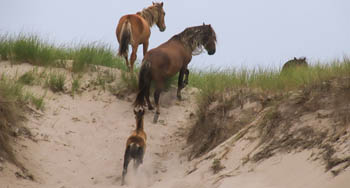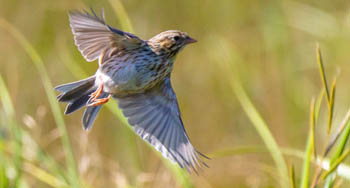
Fences in the Sand
Sable Island National Park Reserve
A new exclosure study by Parks Canada and the Sable Island Institute will help us better understand the role of horses on the ecosystems of Sable Island National Park Reserve.
Temporary fences will create exclosures to keep horses from walking through or grazing in nine small areas on the island. Scientists will measure and compare a number of key ecological attributes inside the exclosures and outside in control sites (similar areas but without fences).
The goal of the study is to understand direct and/or indirect influences of horses on:
- Dune processes (like erosion).
- Ecological integrity of freshwater ponds, including rare plants, water quality, and invertebrates.
- Rare species and their habitats, including Roseate terns, Ipswich Sparrows and rare or endemic insects. This includes observing changes in plant and soil characteristics.



How many horses are there on Sable Island?
Since their protection in 1961, the horse population has been steadily increasing with the population fluctuating between 450 and 550 in recent years. Parks Canada considers the Sable Island horses part of the island’s ecosystem and, as such, protects them as wildlife under the Canada National Parks Act and the National Parks Wildlife Regulations. This important work will enable Parks Canada to deliver on its commitments to maintain ecological integrity at Sable Island National Park Reserve.
Are the fences safe for horses?
Electric fences are regularly used for horses and are designed to startle, not harm the animals. After consulting with experts in the field, electric fences were deemed to be the safest. The fences will be checked regularly to ensure the safety of horses.
How big are the exclosures?
There will be nine fenced exclosures. Each exclosure will be one hectare. This represents 0.6% of the total vegetated portion of the island. Three smaller ponds will be exclosed. This represents approximately 5% of the fresh water reserves.
Could these exclosures limit the amount of food available to the horses?
The horses do not live and breed in a tame condition or depend on humankind for survival. The horses feed primarily on the abundant marram, or beach grass, that covers a third of the island’s surface, and supplement their food intake by eating various other plants, such as beach pea, sandwort, and even some algae that washes up on the beach.
The exclosures represent a very small fraction (0.6%) of the vegetated portion of the island. Currently, there is no indication that forage is limiting for the horses, as their abundance has been steadily increasing since 1961.
Pond exclosure locations were selected in areas where other nearby ponds exist to provide an alternate source of water. As part of this project, three smaller ponds will be exclosed which represents approximately 5% of the fresh water reserves. Horses will have access to water from the many other ponds, from wells that they dig themselves, and from the abundant standing water in the wetter seasons.
How long will the exclosures remain in place?
Researchers will survey the exclosure sites prior to fence construction to establish a baseline and then monitor the exclosures for four years.
A Parks Canada Conservation and Restoration (CoRe) program
The Fences in the Sand project is part of the Parks Canada Conservation and Restoration (CoRe) program. The Government of Canada provides a federal investment of $15 million annually to support high priority projects that make a difference on the ground in maintaining or restoring ecological integrity and helping in the recovery of species at risk.
- Date modified :